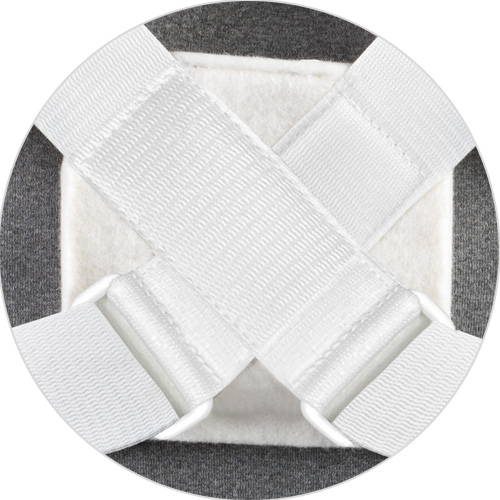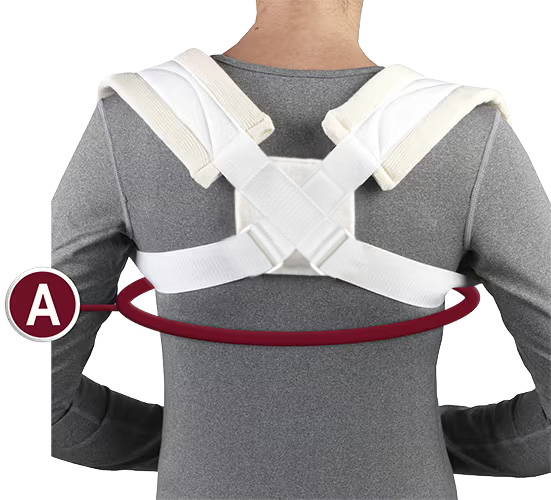2453 / FIGURE-8 DESIGN CLAVICLE STRAP
The OTC 2453 lightweight clavicle strap holds the shoulder area in the correct position to help promote the healing process following a clavicle or shoulder injury. It can also be used to help correct simple bad posture. The strap has a figure-8 design for easy application, and varying degrees of support can be obtained by adjusting the tension of the shoulder straps.
Indications Listed Below
• Provides support and stability to the clavicle and shoulder area
• Wide, comfortable figure 8 shoulder straps minimize binding
• Hook and loop closure provides firm support and easy adjustment
• Extra long straps can be trimmed as necessary
• Can be worn inconspicuously under clothing
• Latex free
Product Features
Padded Shoulder
Padded shoulder straps, 3" wide, minimize uncomfortable binding over the shoulder and under the arms.

Figure-8 Design
Figure-8 design for easy application and adjustment. Large felt back panel evenly distributes support over the entire shoulder area.
How to Measure for and Apply the CLAVICLE STRAP
| MEASURE CHEST CIRCUMFERENCE AT THE LEVEL OF THE UNDERARMS | |
|---|---|
| X-SMALL | 20” - 24” (50.8 - 61 cm) |
| SMALL | 24” - 30” (61 - 76 cm) |
| MEDIUM | 30” - 36” (76 - 91 cm) |
| LARGE | 36” - 42” (91 - 107 cm) |
| X-LARGE | 42” - 48” (107 - 122 cm) |
MEASURING Instructions
A. Measure chest circumference at the level of the underarms
Application Instructions
1. The garment should be applied with the patient standing in a comfortable and correct posture.
2. Position the garment so that the square panel is centered against the shoulder blades side to side and top to bottom, with the straps draped over the shoulders and dangling in the front.
3. Fasten the shoulder strap on the uninjured side first. Then fasten the strap on the injured side, gently adjusting bilaterally until the shoulders are back, but not hyperextended.
4. When properly applied, the support should fit snug but not so tight that it deeply depresses the skin.

Medical Applications
Review the accompanying chart to determine the product that best suits your needs. On the left, you will find a variety of injuries that OTC products are specifically designed to treat and prevent. On the top, you will find the product numbers of all OTC shoulder and clavicle products. If a red box is present where the column and row intersect, your injury or condition is treated/prevented by the associated product.
| 0327 | 2441 | 2451 | 2452 | 2453 | 2454 | 2455 | 2456 | 2464 | 2465 | |
|---|---|---|---|---|---|---|---|---|---|---|
| Bursitis | ||||||||||
| Cervical Impairment | ||||||||||
| Clavicle Fracture / Separation | ||||||||||
| Herniated Cervical Disc | ||||||||||
| Kyphosis / Kyphoscoliosis | ||||||||||
| Lordosis | ||||||||||
| Osteoarthritis | ||||||||||
| Slumping Shoulders | ||||||||||
| Poor Posture | ||||||||||
| Post-operative | ||||||||||
| Rotator Cuff Injury | ||||||||||
| Shoulder Dislocation / Instability | ||||||||||
| Shoulder Sprain / Strain | ||||||||||
| Bicep / Rotator Cuff Tendonitis |
Common Conditions of the Shoulder
Cycle through the slides below to familiarize yourself with several common conditions associated with the shoulder. The conditions decribed below may not be treated by the specific product listed above. Please view the above Medical Applications Chart to determine what conditions this page's associated product treats.
The Anatomy of the Shoulder
FRONT OF THE right SHOULDER
A. Clavicle
B. Bursa
C. Subscapularis Tendon
D. Subscapularis Muscle
E. Humerus
F. Scapula
G. Sternum
Posterior OF THE right SHOULDER
A. Clavicle
B. Spine of Scapula
C. Rotator Cuff
D. Scapula
E. Humerus
F. Spine
